Speed hosting is the foundation of a well-performing high-performance website. Find out why you should care about site speed for the sake of rejection rates, conversions, SEO on Google, cost of Google Ads and user experience. Learn what affects website speed and what to look for when choosing fast hosting. Also learn about 3 tools to test your website and hosting speed.
Why does website speed matter?
.
Every year we have faster and more powerful computers, tablets and smartphones. Their computing power is growing as fast as the average internet speed in Poland and the world. It would seem that as the speed of devices and the internet increases, the speed at which websites load should also increase, but this is not the case.
With the development of the Internet and web development technology , websites are growing and becoming more complex. This is caused by additional scripts, advanced social mechanisms, plug-ins and add-ons. With the passage of time, serIs are not at all faster and do not load any shorter today than they used to.
And is it important for a website to load as fast as possible on the devices of your audience, readers or customers? Definitely yes!
Page speed vs. rejection rate
.
The first and probably the most important factor to pay attention to in terms of website speed is the rejection rate (bounce rate). This is an indicator that tells us what proportion of users will leave our site without performing any action.
And in this case, I’m not talking about the bounce rate, which you may know from Google Analytics. If a page loads for a few seconds or so, the Google Analytics tracking script will often fail to load. Some people will simply close the tab or browser window when the page doesn’t load fast enough and never return. Such a user will not be counted in Analytics and similar statistics.
According to a 2017 Google study, a increase from 1 to 3 seconds of page loading, increases the rejection rate by 32%, and from 1 to 5 seconds by 90%.

Pingdom’s tool examined how the average rejection rate on pages varies with page load time. An increase from 2 to 3 seconds almost doubles the rejection rate. And from 3 to 4 seconds, it even more than doubles. The owner of a page that loads on a user’s device for more than 6 seconds must expect that the bounce rate can be more than 50% (more than half of the people will abandon their visit).
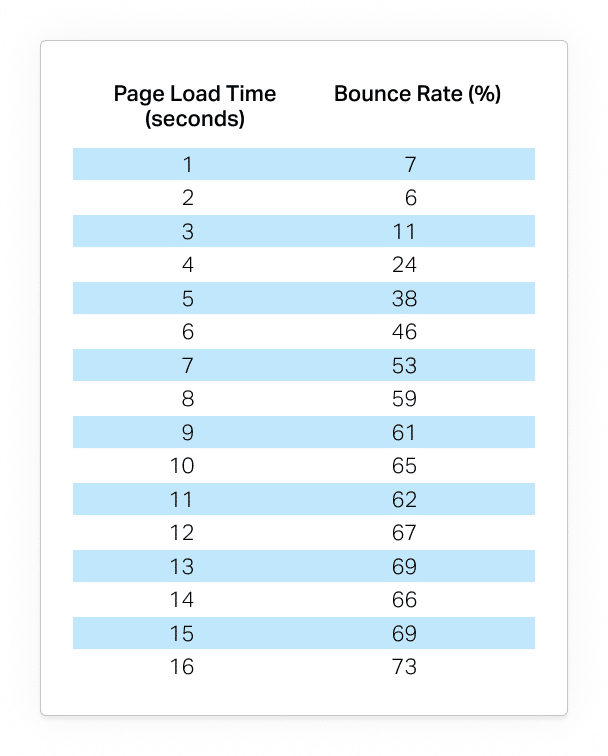
A fast page, then, means a lower rejection rate, and thus, ultimately, more visitors. And in the end, that’s what we care about.
Page speed vs. conversion
.
Another super-important issue affected by website speed is conversion. The conversion rate is the percentage of users who perform a desired action on a page. This could include reading an article, watching a video, placing an order, submitting a form or contacting us by phone.
Conversion is the most important thing we want a web visitor to do. It’s a business metric that, in most cases, should determine how effective a Web site is. If an action is performed by, say, 1 in 1,000 users (conversion: 0.1%) it’s rather poor, and if 1 in 10 users (conversion: 10%) it’s great. Although ultimately it all depends on your business goals.
And it turns out thatthe loading speed of a website has a directly proportional impact on the conversion rate. And this is true whether we’re talking about an e-commerce business, a blog, a landing page or, for example, a simple company website with an offer.
According to Google research, every second a page loads on a mobile device, there is a 20% lower conversion rate..
Based on a slightly different study, an interesting graphic demonstrating this issue was prepared by Cloudflare:

Speedier page load time therefore means much higher conversion. And higher conversion means higher revenue and profits in your business regardless of whether you’re selling shoes in an e-commerce site or we’re talking about a site with funny pictures that makes money from ads.
Site speed vs SEO
.
Whether a website runs fast also matters to Google’s search engine. In 2010, Google’s blog reported that site speed is one of the factors affecting Google’s ranking.
At that time, according to the company, it was still a factor that affected positions only slightly. However, in January 2018 , implementing the so-called Speed Update a few months later, Google officially announced that page speed affects the ranking and positions of pages in organic search results.
Independent research on the issue was conducted by Neil Patel, among others, who checked the results in Google for 5,000 random key phrases and examined the speed of 143,827 URLs appearing in search results. The conclusions? The lower the TTFB (time to first byte, i.e., the time until the first information is sent by the server hosting the page), the higher the page rank.
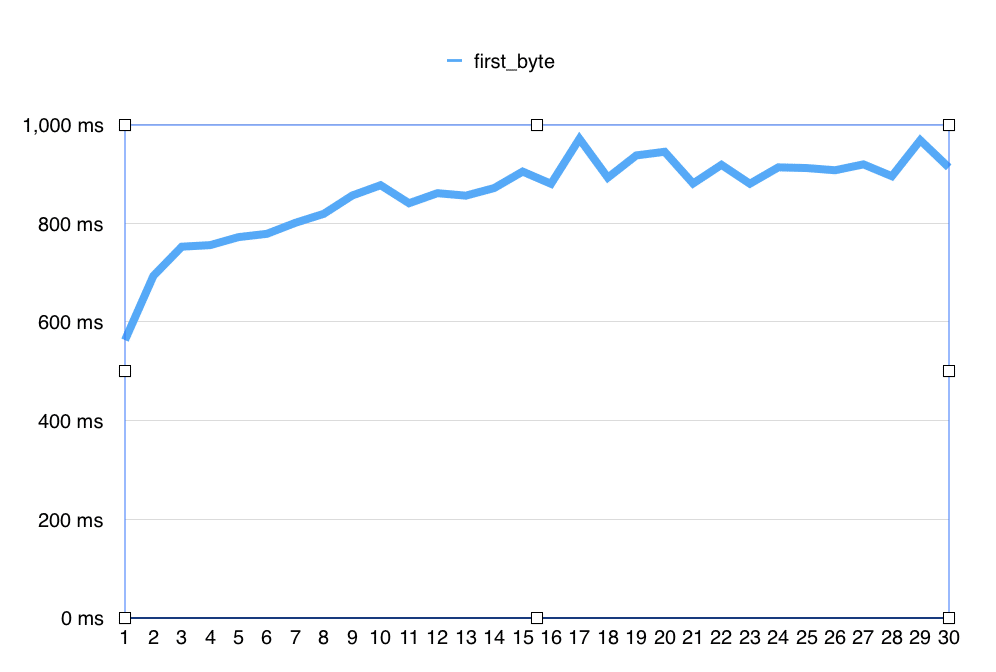
To be fair, it should be noted that there are studies that don’t quite agree with this thesis. Researchers from baclinko.com, who examined page load times from TOP 10 results for 11.8 million keyword phrases, say that while a slow-performing site can negatively affect Google’s position, the top 10 results (which were analyzed in this study) show no direct correlation between page speed and position. Pages in positions 1-10 tend to be relatively faster than URLs on subsequent Google results pages.

In 2020, Google announced a new initiative called Web Vitals (Core Web Metrics). It’s a set of 3 key aspects of web page load time that website owners and developers who want to ensure user experience and good ranking on Google should focus on.
As of 2021, Core Web Vitals are expected to be the factors responsible for user experience that will affect the ranking, and visibility of websites on Google. You can check the Core Web Vitals indicators in the Google Search Console tool, among others.
Some SEO specialists also suspect that a factor affecting a website’s position in Google is (or may soon be) the so-called dwell time, which is the time between clicking on a link in search results and returning from the website to Google. The slower the page, the greater the chance that the user will not wait for it to load and will return more quickly to the results list to visit the next page from the results.
Definitely, Web site speed has a direct impact on a site’s visibility on Google, so if you care about getting traffic from the search engine, it’s worth making sure you have a fast server and an optimally built website.
Site speed vs. Google Ads
.
But Google’s organic search engine results aren’t everything. After all, Google still has its own advertising system, through which we can advertise in search results, as well as in the ad network on external websites. But does the speed of the site in any way affect the paid ads purchased from Google? It turns out that it does.
We’re talking about the quality score, which is Google’s assessment of each ad aired in Google Ads. The quality score consists of 3 elements:
- .
- Predicted ad click-through rate
- The accuracy of the ad
- The quality score of the landing page
.
.
.
Have you already guessed in which of these elements the issue of website speed might be hidden? Yes, it’s about assessing the “quality” of the landing page targeted by the ad. Google lists speed as one of the factors it considers when evaluating the quality of an ad:

“The page loads quickly […]” (from support.google.com)
And what does a high ad quality score do in practice? The quality score directly affects how much you will pay for each click on your ad. The higher the quality score, the lower the cost per click (CPC). Within the same advertising budget, we are able to get more clicks to our website. Is this worth fighting for? In my opinion, yes.
Page speed vs. user experience (UX)
.
And finally, I left the issue ofuser experience of visiting a fast site. It should be important to any web designer, website traffic soliciter, or ultimately business or other venture owner that the user visiting a website is satisfied with the visit.
After all, when designing websites, we try to guide the user “by the hand”, showing him what we have to offer and what he should do. For example, if we have an online store, we want to make shopping there as pleasant as possible. And if we have a blog, for example, we want readers to read our post in peace and sign up for the newsletter later.
When a visitor’s experience is good, they are inclined to come back to us and recommend our site or services to friends. After all, that’s what we care about, right?
Meanwhile, I found a study by Ericsson that examined the level of stress experienced on various occasions. And what does it turn out? Delays on mobile devices induce comparable levels of stress to watching a horror movie..

Is this something we want to fund to our website visitors? I assume not. It is worthwhile to take care of page speed as a part of user experience (UX), i.e. users’ experience of visiting us online.
Summary
.
With a faster Web site, we can count on:
- more people will become familiar with the site
- the site will have a higher conversion rate
- the site will get higher rankings and more traffic from Google
- we will pay less for ads
- users’ satisfaction with the site visit will be higher
.
.
.
.
.
And this applies to blogs, news sites, corporate business card sites, online stores, SaaS services or any other sites. Simply fighting to slash every millisecond in page load speed is worthwhile and can bring tangible and quantifiable benefits..
What affects page speed?
.
Many factors affect how fast a page ultimately loads on a user’s end device. Some of these are beyond our control (e.g., the site visitor’s internet speed, the performance of his device), but most of the issues that matter are within our real control.
I would divide the factors affecting the speed of the site that the owner/developer has influence over into 2 categories.
1. back-end of the website
-
- optimal code (e.g., readable, simple code or number of WordPress plugins)
- .
- hosting (e.g., database speed, disk speed or HTTP protocol used, etc.)
.
2. front-end of the website
-
- quantity of “external” materials (e.g., analytics scripts, widgets, chatbots, fonts – Google Analytics, Facebook pixel, YouTube video embed, etc.)
- Name and size of files.
There’s a little bit of that, and some of the things mentioned intersect (e.g., optimal code without unnecessary additions should be on both the back-end and front-end). However, it is true that not everything can be described within a single article. In this one today I will focus exclusively on the absolute fundamental of site speed, which is fast and efficient hosting..
Hosting is the foundation of any website’s performance. An efficient hosting environment and a reserve of “power” allows any site, even the most poorly optimized one, to spread its wings when it comes to speed. Conversely, even the best-prepared from the programming side, a fast website will not work efficiently if the hosting is slow.
What to look out for when choosing high-speed hosting?
.
Now that we know the speed of websites is important and that hosting is one of the most important elements affecting the speed of a website, let’s consider what characterizes fast hosting. What elements of the offerings of hosting companies to pay attention to in order to choose a hosting that will be the foundation of our building a fast website.
Below I have prepared a list of elements that are worth paying attention to in the offer of hosting, whose task will be primarily speed.
Processor (CPU) and memory (RAM)
.
Intuitively, most of us know that the faster the processor and more RAM in a computer, the faster it will run. When choosing a computer for work, we usually carefully check what kind of processor it has, how many cores it has and how it is clocked. We often wonder if it’s worth paying extra for more RAM – 8 GB, 16 GB, or maybe 32 GB of RAM?
But for a reason unknown to me, when it comes to choosing hosting for our website, blog or store, we completely forget about parameters such as processor or RAM. And yet hosting is ultimately a server similar to our home computer or laptop. And the better/faster we have the processor and more RAM, the faster the websites will run.
Of course, with shared hosting, we don’t have exclusive use of the entire machine (as in the case of buying a dedicated server). Often, we also do not have at our disposal guaranteed resources such as RAM or CPU (as in the case of VPS servers). However, in the hosting offer we should find information about how much processor and how much RAM we will have at our disposal.
What do these parameters look like in offers?.
- RAM is given in MB (megabytes) or GB (gigabytes). E.g. 256 MB, 512 MB, 1 GB, 2 GB
- Processor (CPU) is given in number of cores (e.g., 2 cores), vCore (e.g., 1 vCore), MHz or Ghz (e.g., 500 MHz, 1 GHz) or percentage (e.g., 100% CPU, 200% CPU)
.
.
Unfortunately, not all hosting companies provide such information directly in their offerings. With some of them, information about available CPU and RAM in particular hosting packages is hidden on help pages, in terms and conditions, “technical details” or on pages called “security limits”.
However, it’s worth digging deeper on the site and choosing a hosting (and hosting plan) that offers minimum 1 CPU core (or 1 vCore / 1 GHz / 100% CPU) and minimum 1 GB RAM. These are parameters that should, in most cases, be enough to make the sites run fast.
If you are already using hosting, the CPU or RAM consumption can be checked in some hosting companies after logging into the hosting management panel.
Speed disk
.
Maybe some of you remember the “switch” from platter HDDs to SSDs. Aside from the quietness or lower power consumption of our computers, the biggest noticeable difference was… a giganticacceleration of computer performance. Suddenly the operating system was booting much faster, suddenly the browser was loading in a flash.
And while today SSDs are standard in most personal computers or laptops, not necessarily so for hosting – which also, after all, stores our data on hard drives. To this day, many companies still offer hosting accounts based on “old” HDD platters, which are many times slower than their successors.
What types of disks can we find on web hosts?.
- HDD, that is, standard platter hard drives.
- .
- SSD, or much faster solid-state memory.
- SSD.
- NVMe SSDs, which is the fastest type of SSDs (up to 10-11x faster than regular SSDs).
And what are the write and read speeds on such drives?

In addition to the above-mentioned speed of reading and writing files to the disk, given in MB/s, an important parameter in the speed of the disk (and the entire hosting) is IOPS, or the number of operations per second. The higher it is, the faster the hosting will be able to read various information from the disk (and write it) and the faster your pages will run. Remember that each display of a web page, blog or store, generates a lot of operations to read and write various data on the server’s disk.
When choosing high-speed hosting, in addition to the type of disk, also pay attention to whether:
- all data is kept on SSD or SSD NVMe (some hosts only keep part of the data, such as MySQL databases, on faster drives, and the rest – such as files and mail – on slower HDDs).
- hosting does not limit IOPS (some hosts offer high-speed NVMe SSDs, but limit their bandwidth for each customer).
For hosted mail service, disk speed doesn’t matter much, but for site files and databases it already matters a lot. As for IOPS, on the other hand, if there is already such a limitation, it is worth making sure that the limit is a minimum of 100 IOPS. The ideal high-speed hosting is one that 100% of the data is stored on NVMe SSDs and there are no limits on writes and reads..
HTTP/1.1, HTTP/2 and HTTP/3
.
The first website was created 30 years ago. It was launched in December 1990 by Tim Berners-Lee, a British physicist within CERN, or the European Organization for Nuclear Research. And it was a breakthrough, because today we can’t imagine the Internet without websites.
The HTTP protocol determines how a browser (e.g., on a computer or phone) communicates with a server, or host, that runs Web pages. The protocol has seen some major changes since its inception. HTTP/1.1 can be considered prehistoric, as it premiered in 1997. And although a lot has changed since then, and websites look very different, it is still widely used.
Read also: Http response codes, or 404 error and more. What is your browser telling you?.
Today’s Web pages consist of many graphics, images, CSS styles, JS scripts. Often they are not simple static pages, but complex applications such as mail in the browser, or even an online store with a shopping cart or shopping lists.
This requires a different HTTP protocol, and one was unveiled in May 2015. It was called HTTP/2, and at the time of its release, it was already supported by most major browsers on the market (Chrome, Opara, Firefox, IE, Safari, Edge). Unfortunately, today only 47% of websites still run on HTTP/2 (W3Techs data).
And that’s a shame, because sites running on HTTP/2 are definitely faster thanks to, among other things:
- active uploading of necessary files by the site, without waiting for the browser to “request”
- transferring multiple files simultaneously, instead of one at a time
- using a single connection to transfer all data, instead of separate connections
- built-in header compression
.
.
.
.
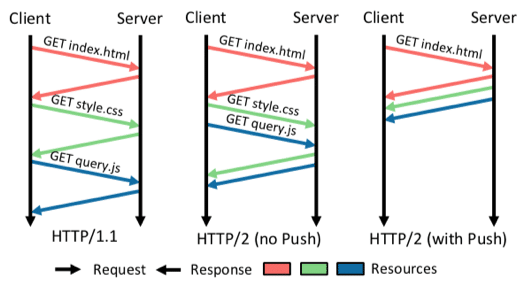
Thanks to all these improvements, the final web pages load much faster, and the hosting is able to handle all requests faster.
HTTP/2 is fully supported by Google’s indexing robots (which are based on Chrome) and site speed testing tools from Google, such as PageSpeed Insights.
So when choosing a fast web host, choose a company that offers its customers HTTP/2 support so that pages load faster. As I write this, the implementation of HTTP/2’s successor, the HTTP/3 protocol, is nearing completion. And already some web hosts are also testily offering support for this next-generation standard, which will once again speed up websites. It’s worth keeping an eye on.
Server software type
.
Hosting works on HTTP server software, whose task is to handle requests, process them and serve web pages to end users. And just like any software, we can encounter faster and slower solutions.
In the case of hosting, we can most often encounter three types of server software: Apache, Nginx and LiteSpeed.
The slowest solution of the aforementioned three is Apache, on the second place of the podium is – the most popular in the world today – Nginx. The winner of most of the performance tests you can find on the web (and conduct yourself) is LiteSpeed, which is even much faster than its competitors.
Below are the results of various speed tests of sites running on HTTP/2 with litespeedtech.com:
- WordPress: LiteSpeed is 12x faster than Nginx
- Magento 2: LiteSpeed is 3x faster than Nginx
- Joomla: LiteSpeed is 426x faster than Nginx
- PrestaShop: LiteSpeed is 1000x faster than Nginx
- OpenCart: LiteSpeed is 2002x faster than Nginx
- Drupal: LiteSpeed is 7x faster than Nginx
- PHP: LiteSpeed is 1.3x faster than Nginx
- Small static files: LiteSpeed is 6x faster than Nginx
.
.
.
.
.
.
.
.
LiteSpeed, in addition to server software for web hosts, also offers free plugins/add-ons to optimize and speed up websites through caching, file minification and other treatments in cooperation with the server software. Such plugins can be found for WordPress, Magento 1.X and 2.X, Joomla, Prestaschop, OpenCart, Drupal 8, XenoForo 1.X and 2.X, MediaWiki, Laravel or Shopware, among others.
From my “wordpress experience”, I can say that using LiteSpeed-based hosting andapplying the LSCache plugin to a WooCommerce-based blog or store really gives great results. And with the proper configuration of the plugin (minification of CSS, JS files, compression of images and photos, etc.), we can practically dispense with other optimization add-ons, enjoying a fast and efficient website, blog or store.
When looking for hosting that will be fast and efficient, I recommend you definitely pay attention to the software on which the hosting runs and bet on the offer of a company that offers its services based precisely on LiteSpeed.
P PHP version
.
PHP programming language was presented in 1994/1995. Today, it is the most widely used language for web server-side scripting in the world. Most dynamic websites (including popular CMSs such as WordPress) are based on PHP.
And just like any software, this programming language evolves over time. Successive updates, in addition to fixes to improve the security and stability of our Web sites, also bring faster PHP scripting support, and thus faster Web pages.
In recent years, we’ve seen the biggest jump in performance by upgrading PHP from version 5.6 to 7.0. But each successive version also brings improvements that increase the speed of Web pages. Below is a graph of site performance on WordPress as PHP versions change:

Problems with PHP in hosting companies are two:.
- Some web hosts rarely update PHP and are not very eager to provide their customers with the latest versions.
- The PHP version change is usually not automatic. It’s up to the site owner himself to swap the PHP version to a newer one.
- The site owner has to change the PHP version himself.
.
And while we can easily deal with the second problem by looking into the hosting management panel from time to time to change the PHP version to a newer one, there is not much we can do about the sluggishness of our hosting anymore. Currently, new “major” versions of PHP are released every year and then actively supported for 2 years, and for another year they can only receive updates for critical security vulnerabilities.
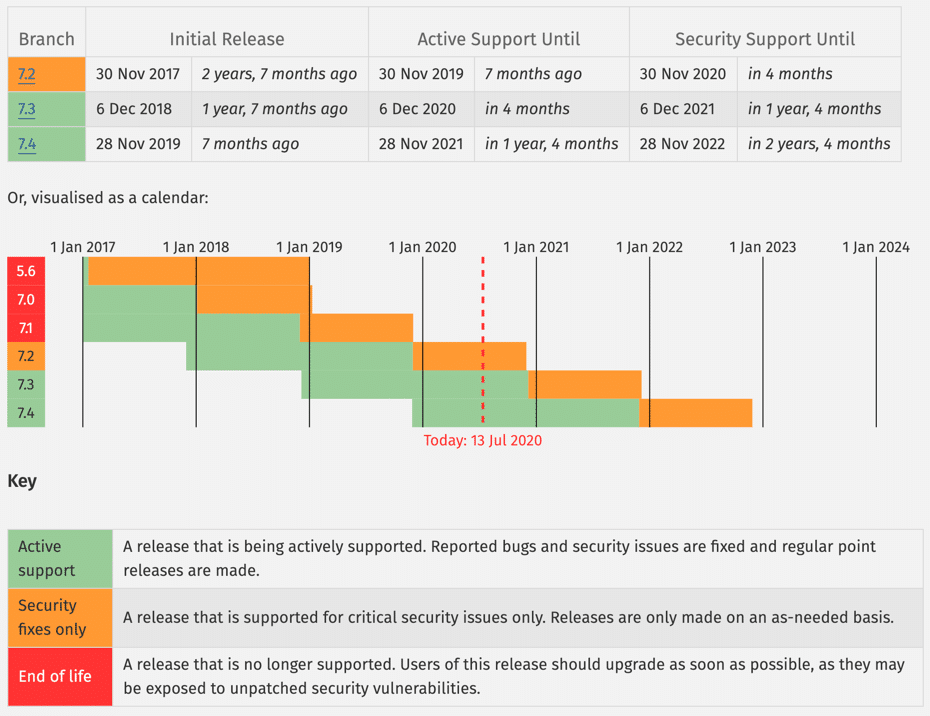
So if you’re looking for fast and efficient hosting, it’s a good idea to check what version of PHP the company offers before choosing a particular offer. And whether it is the latest version that is and will be actively supported in the near future.
Redis and Memcached.
Redis and Memchaced are two similar solutions.They are modern NoSQL databases with exceptional performance and high content availability. And where does this performance come from? Well, the reason is thatthe data in a Redis or Memcached database is not stored on disk, but remains in RAM. And that, among other things, storing them in memory makes them many times faster than standard databases or other solutions.
Well. But while this may matter to developers, creating custom software that will take advantage of these and other benefits of Redis or Memcached,what about ordinary websites, blogs on WordPress or online stores? After all, they are mostly based on standard MySQL-type databases.
Redis or Memcached can be used as a cache system, which will store information in RAM, for example, about the content of popular blog posts, search results in the store or, for example, about the products offered and their parameters. Or the contents of e-shop customers’ shopping carts.
Such an action canextremely speed up the loading time of dynamic web pages, which instead of executing a query to the MySQL database (which takes a lot), retrieve the most relevant information from the Redis or Mamcahced database (which is definitely faster).
And for implementation, all it often takes is a simple WordPress plugin (such as the aforementioned LSCache or Redis Object Cache) and a few clicks to set up the connection.

Are you looking for a hosting where your sites will run fast? Choose one that offers a Redis and/or Memcached solution. And enjoy the benefits of these solutions.
Hosting link speed
.
How fast is your Internet connection at home? How about on a mobile connection on a smartphone? And what kind of connection does your web hosting have? – You also wonder why this last question is asked by almost no one?
And yet the hosting company – just like you at home – has some kind of specific and limited Internet connection, which is hooked up to the server on which web hosting is offered. So why is it that the first thing you do, while still at the installer who has just hooked up your apartment to the Internet, is run SpeedTest to check your Internet connection, but you don’t do the same on the hosting?
There’s one hitch with this internet speed testing at the hosting company. It is not an easy task. Especially since we have to keep in mind that the hosting link is shared among all the other customers of the hosting company, using that particular server.
So there is nothing to rub against the declarations of the hosting company – this is an issue that we need to test ourselves, using, for example, a free hosting trial period. How to do it? Methods for checking the web hosting link are several.
First, we can upload to the hosting as large a file (such as a movie). This can be done via FTP or, for example, uploading media or files in WordPress or other software. By uploading, we will see at what speed the file is uploaded, and later by downloading it again, we can see at what speed it is uploaded. It’s a simple solution for anyone, but unfortunately it requires a fast Internet connection.
The second way is a bit more difficult, because it requires access to SSH, the hosting command line. After logging in, we can download and run Speedtest-CLI, a command-line version of Speedtest.net. It works analogously to checking the speed of a link (download/upload) through a browser, except that the results are displayed in the console.
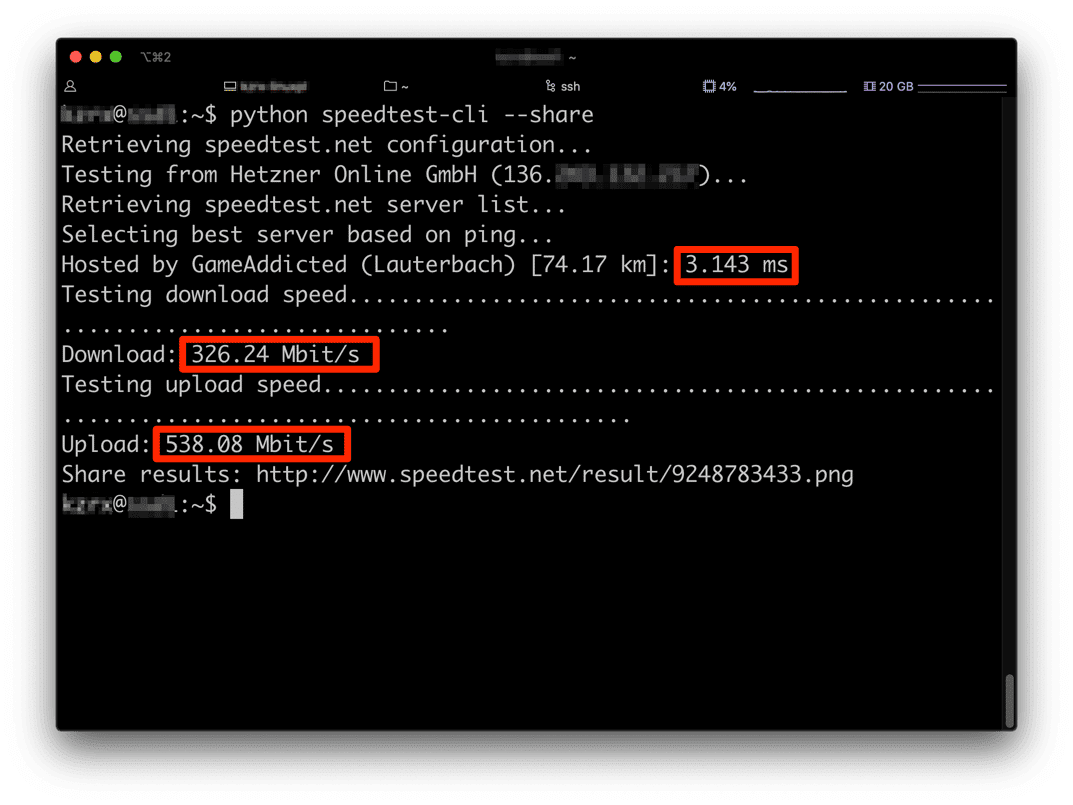
It’s a good idea to test the speed of the hosting link several times on different days or at different times of the day to make sure that the bandwidth does not drop drastically, for example, in the evening hours or on weekends. Average test results above 100 Mbps for hosting should be OK.
Speed of DNS servers
.
The last issue worth verifying in terms of hosting speed is the response speed of DNS servers.
DNS is a kind of Internet address book that translates domain names (e.g. mojafirma.pl) into server IP addresses (e.g. 123.123.12.1). Every time we want to visit a site, our hosting company’s DNS servers are queried asking “Where exactly is this Web site?”. After a period of several to hundreds of milliseconds, our computer or smartphone receives a response along the lines of “This website is at IP address: XX.XX.XXX.XX”.
This exchange of DNS queries between our device and the web host, is each time part of the page load, so the shorter it takes, the faster the end user will get where he or she needs to be, and the page will load on his or her device.
This is another issue that we won’t read in the hosting company’s offer, but which we need to test ourselves. Fortunately, in this case we won’t be forced to perform strange tricks with uploading or downloading files, or running command lines. We’ll use the online DNS Speed Benchmark tool from DNSPerf for testing.
After entering the address of a site that runs on a given hosting (and uses the hosting’s DNS), we select the territorial range, i.e. where the hosting’s DNS servers are to be tested from. We can choose from: the whole world, specific continents or countries. For Polish sites, aimed mainly at Polish users, it’s enough for us to check DNS for Poland or possibly Europe. Click and we have the results.

Interesting fact: Googlebot (i.e. Google’s site indexing robot) usually visits sites from servers located in the USA (though not only). Check how quickly your hosting responds to DNS queries from the US.
When looking for a web host, it’s a good idea to choose one that offers fast DNS servers for its customers. Alternatively, you can bet on a hosting that offers DNS Anycast service, which relies on DNS servers scattered in several-some locations around the globe, thus serving queries from different parts of the globe faster.
How to test the speed of a website and hosting?
.
An integral part of web site improvement is testing. Here there is nothing to operate “by feel”.
Just because a website loads quickly on new corporate hardware hooked up to high-speed internet, doesn’t mean it will work just as well on a budget smartphone from 5 years ago, used en route on a train where there is no WiFi and you can barely catch 3G. And that may be where and when your potential customer wants to visit your site. And you have one chance to present yourself well and make a good first impression.
That’s why it’s important to use appropriate website testing tools (and hosting) that, among other things, will be able to simulate a site visit from a slightly weaker device or slower network connection.
I have prepared below proposals of 3 good and proven tools with which you can test the speed of your website and the hosting it runs on.
How to test the speed of a website and hosting?
.
But before I get to the specific tools, two more comments about the testing itself, because in order to do it well and for the results to be reliable, it’s worth knowing about them.
1. Test the most important subpages (not the main page).
Most people enter the home page address into the web speed testing tools. But does a fast home page, mean that the entire Web site is fast? Not necessarily. Especially since the home page is usually not the most visited subpage within a website.
What are the most important sub-pages on your site?” In the case of a blog, for example, it may be the page of a particular blog post that is the most popular and most blog visitors go to it. In the case of an online store, it may be first the page (card) of a particular product that is a bestseller, and second the page of a category or subcategory with a list of products.
For inspiration, you can take a peek at Google Analytics under Behavior -> Site Content -> All Pages. There you will see the most popular pages within your site.

So designate the most important sub-pages within your website and test them all. The home page can be one of them, but it should not be the only one.
2. Test repeatedly.
Only one test is not enough. One moment a page may load quickly, and a moment later it may take forever to load. This is especially noticeable during so-called Internet rush hours, i.e. evenings and weekends, when more people are simultaneously using the Internet after school or work. At such times, traffic across the Internet increases, and our hosting may no longer be as fast with more visitors to the site.
That’s why it’s a good idea to test the speed of the site (and hosting)at different times and on different days. In the morning, during the working day, in the evening, during the week and on weekends. And observe whether the result is similar or differs significantly. If they vary, despite the fact that the page content itself does not change, the problem most likely lies with the hosting throne, which simply “does not perform”.
Google PageSpeed Insights
.
The first tool is Google’s PageSpeed Insights (PSI). The tool is currently based on both lab data from Lighthouse and collected real-world Chrome browser data from site visitors. After many improvements, it can currently be considered one of the best online tools for testing website performance and speed.
When you type in a website address, you get results in 2 categories:
- on mobiles
- on computers
As I mentioned earlier –the device on which we visit the site matters quite a bit, when it comes to its speed.
Each of these views has a separate overall rating on a scale of 0-100, which shows how fast our site runs and how well it is optimized for speed.
- a rating of 100 to 90 points can be considered good
- A rating from 89 to 50 points – for average and in need of improvement
- and a rating of 49 points and less – for poor.
.
.
.
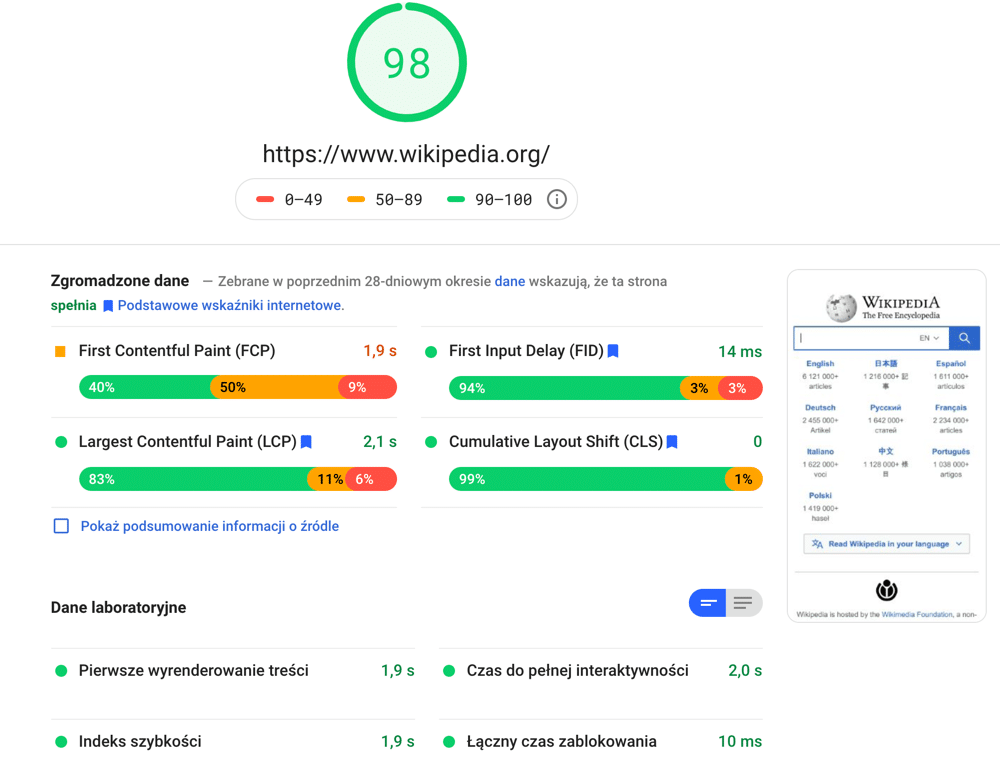
We can’t directly tell from the results what part of the rating the web host is responsible for, but the parameter worth paying attention to from this angle is undoubtedly the “Initial server response time,” or the server’s response time to a query, known as TTFB for short.
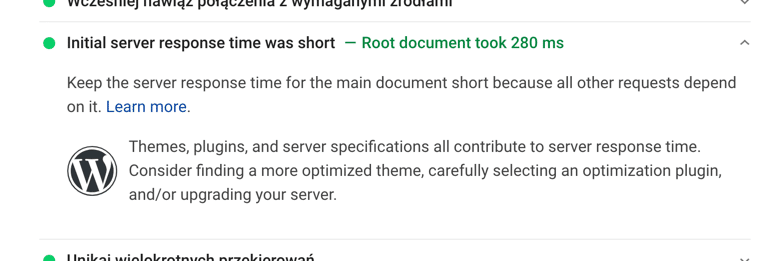

It is worthwhile to ensure that TTFB is as low as possible. Time To First Byte is influenced precisely by fast (or slow) hosting and optimization of the code (back-end) of the website itself (e.g. unnecessary plugins, lack of cache or a poorly written theme in the case of WordPress).
Besides, hosting indirectly affects many other elements, such as redirect time, speed index or first content rendering.
WebPageTest.org
.
Another one of the tools that I can confidently recommend for web speed testing is WebPageTest.org.
It’s quite a powerful tool, and even before the first search, we can, in addition to specifying the tested URL, specify many additional elements, such as:
- from what location the test is to be performed (city and country, e.g., Warsaw)
- from which browser the test is to be performed (e.g. Chrome, Firefox, Opera)
.
.
In the advanced settings, we can also set from which Internet connection the tested page is to be loaded (default: 5/1 Mbps cable), how many times it is to be loaded (default: 3) and, for example, whether to record a video showing how the web page is loaded. So if we want to see how a page loads from Warsaw on an LTE connection, and how from London on 3G, we can set all this. In PageSpeed Insights, we couldn’t do that.

In the results, we get really a lot of data about the speed of the site. In addition to the general information about how fast the page fully loaded (Fully Loaded – Time), we will also get information about how fast the individual elements of the page loaded.
In terms of hosting, which obviously has an impact on page load time, it is worth looking specifically at the TTFB mentioned earlier, which here is simply called First Byte. In addition to listing it in a table, also at the top of the page each element (including First Byte) is rated a US scale from A to F.
Pingdom Website Speed Test
.
The Pingdom Tool is a tool provided by a well-known company that monitors the availability and failure rate of servers and websites.
In the tool, you enter the URL of the site you want to test and select the location from which the test is to take place. Unfortunatelythere is currently no Poland among the locations – the closest would be Frankfurt, Germany.
The result will also give us a score on a scale of 0 to 100 points, the size of the page, the number of page elements and the most important element – its load time (Load time).
And while we’ll find a list of tips for optimizing a page below, these tips won’t be as extensive as in a tool from Google. The scoring based on them also leaves much to be desired.
However, it’s worth peeking a bit below at the File requests section to see on a graph how each element looked and how long it took to load. There you will find, among other things:
- time to look for a response to a DNS query (which I wrote about earlier when checking DNS speed on hosting)
- SSL handshake time
- time to connect to the hosting (Connect)
- time of sending data through hosting (Send)
.
.
.
.
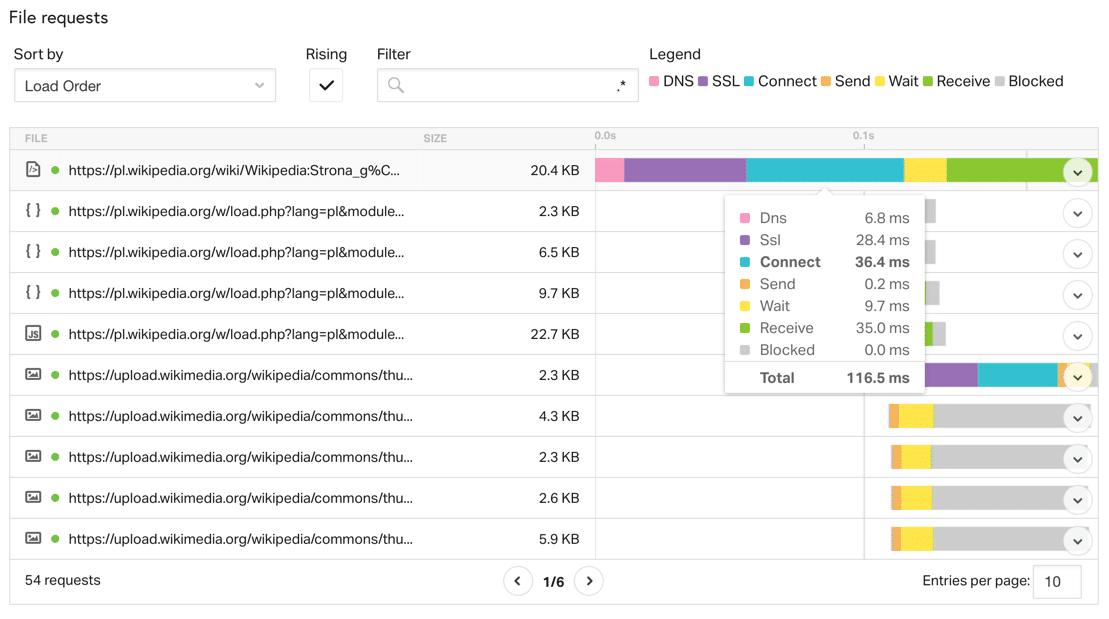
Among other things, fast hosting is responsible for the handling time of all these elements. The more efficiently it works, the shorter the times of the individual stages and the faster the browser downloads the data, and ultimately – the faster the page is displayed by the user.
Summary
.
Let’s summarize the whole article.
- you already know that page load time has a huge impact and directly translates into the number of visitors, conversions, UX, SEO, or advertising costs in Google Ads.
- The basis for the speed of any website is fast hosting. You already know what to look for when reviewing the offers of hosting companies.
- you already know what tools to use to test the speed of your website and hosting and look for tips on optimizing your website speed.
.
.
So I can’t help but wish you good luck and lightning-fast websites. After all – we all like them 🙂
 Mateusz Mazurek
Mateusz Mazurek